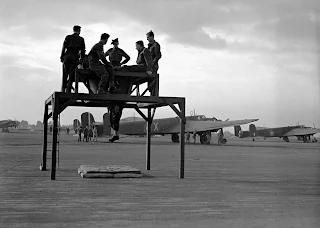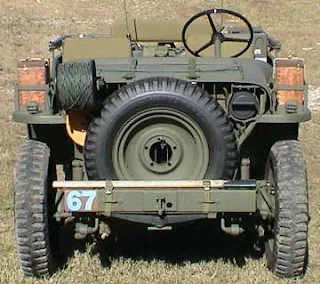Prime Minister Winston Churchill to General Sir Hastings Ismay
22 June 1940
A photographic copy of Prime Minister Churchill's original note to General Ismay.
The following photographs show very early training of British Army paratroops at the then newly established No.1 Parachute Training School, Ringway (formerly Manchester Corporation civil airport). An educated guess would place them on or about April 1941, which was the date when Prime Minister Winston Spencer Churchill paid a formal visit to the facility. Due to the posed nature, and quality of the photography, they may have been taken during a dress rehearsal for the Prime Minister's visit. However, the date could be as much as a year later.
Evident are the early canvas/sorbo rubber training ('bungee') helmets (some even without ear grommets) and first pattern jump smocks, which were copied from the German Fallschirmjager pattern, and predated the Denison Smock. The photographs also provide good detail of the then relatively new 'X' Type Statichute and Service Respirators in their unique carried position. Note two short web 'press the dot' tabs at the bottom corners of the respirator case, facilitating its being carried up-side-down, with ready access even while still descending to the DZ if required.
It is also interesting to note, by virtue of the brevet on their right shoulder, that the majority, if not all of these men, are qualified paratroops. Another uniform item which others may have spotted (I didn't until reviewing magnified photographs) was the Polish eagle insignia (presumably yellow) on some of the sorbo helmets of the paratroops in massed formation, identifying members of the Polish 1st Independent Parachute Brigade Group formed in September 1941 ('TOBIE OJCYZNO'). While helping to date that specific photograph, it should be stated that it was acquired independently from the others in the group.
In addition to the obviously posed sergeant with a .45 cal. Thompson Sub-Machine Gun M1928, it is interesting to note that in some photographs the paratroops are under arms, and in others they are not. It is my best understanding that at that point in time they jumped without weapons (prior to the collapsed 9mm Sten Mk II being tucked into the parachute harness), and retrieved them once on the ground from CLE containers. Also note secondary anti-aircraft hand-grips still on the underside of the stocks of the .303 cal. Bren Mk I Light Machine-Guns.
Also seen are the obsolete (considered infamous by many) Armstrong Whitworth Aircraft Ltd. Whitley Mk II bombers, six of which were used as initial interim transport aircraft for training jumps. Call letters, as can be discerned from the photographs, are 'R', 'T', 'X', 'Y', 'Z', and one aircraft apparently un-lettered. A keen eye will probably also spot the classic double deck bus parked by the hangar, RAF 'Tilly' light utility truck, and the Westland Lysander Army Co-operation aircraft (probably Mk Is) positioned on the airfield, as well as in formation with the Whitleys in flight. Finally, beyond and to the right of the Lysander, barely discernible, are two GAL Hotspur Gliders (unidentifiable Mk at that range).
Although it probably post dates the photographs, by almost a year possibly due to security reasons, the following is the official Army Order formally documenting the formation of both the Parachute Regiment and the Glider Pilot Regiment.
With full acknowledgement and gratitude to the Airborne Assault ParaData web site, the following segment of archival film footage records the visit of Prime Minister Winston S. Churchill to Ringway in April 1941; https://www.paradata.org.uk/media/11569
For those who might be interested in a more extensive history of the development of the British Airborne Forces there is an excellent book; CHURCHILL'S SPEARHEAD, The Development of Britain's Airborne Forces during World War II, J. Greenacre, Pen and Sword Books Ltd., Barnsley, Yorkshire, 2010, ISBN 978-1-84884-271-7.
While hardly Tennyson or Kipling, the lyrics of the songs sung in the previous newsreel camera film footage, may prove interesting in reflecting both the terms and tenor of the times:
ALWAYS KEEP
YOUR TROUSERS CLEAN
(Tune:
Knees Up, Mother Borwn)
When first
I came to PTS, My CO he advised
Take lots
and lots of underwear, you'll need it, I surmise,
By I
replied, "By Gad, Sir, Whatever may befall,
I'll always
keep my trousers clean,
When
jumping through the hole".
[Chorus]
Jumping through the hole,
Jumping
through the hole,
I'll always
keep my trousers clean
When
jumping through the hole.
I went into
the hangar, Instructor by my side,
And on
Kilkenny's Circus had many a glorious ride,
"On
these ingenious gadgets", said he, "You'll learn to fall
And keep
your feet together, when yer jumping through the hole."
He swung me
in the swings boys, he shot me down the chute,
He showed
me the high aperture, I thought it rather cute;
Said he
"This apparatus will teach you one and all
To
centralise your C of G, when yer jumping through the hole.
I saw the
glorious statichutes, with camouflage design,
I heard the
Warrant Officer shoot such a lovely line,
"This
loverly bit of stuff, lads," said he, "Upon my soul,
T'is
sweeter than your sweetheart, when jumping through the hole."
One morning
very early, cold and damp and dark,
They took
me in a so-called bus, out to Tatton Park,
In keeping
with the weather, I said to one and all,
"I
take a dim and misty view, of jumping through the hole."
He fitted
me with parachute and helmet for my head,
The
Sergeant looked with expert eye, "It fits you fine," he said,
"I'll
introduce you now to 'Bessie', that's what we call the nice balloon
From which
you'll very soon be jumping through the hole."
"OK -
Up six hundred! Four to drop," said he.
"Four
to drop? Good God!" I cried, "And one of them is me!"
So clinging
very tightly to the handles on the floor,
I cursed
the day I volunteered for jumping through the hole.
Sarg' told
a funny story, I couldn't see the joke,
In fact, I
thought he was a most unsympathetic bloke,
But when he
shouted "Action stations!" and then he shouted "GO!"
I simply
couldn't stop myself from jumping through the hole.
I hit my
pack, I rang the "bell", I twisted twenty times
I came down
with both feet entangled in the rigging lines,
But
floating upside down to earth, I didn't care at all,
For I had
kept my trousers clean when jumping through the hole.
COME SIT BY
MY SIDE IF YOU LOVE ME
(Tune: Red
River Valley)
Come and
sit by my side if you love me,
Do not
hasten to bid me adieu,
Just
remember the poor parachutist,
And the job
he is trying to do.
When the
red light goes on we are ready,
For the
sergeant to shout "Number One"
Though we
sit in the plane close together,
We all
tumble out one by one.
When we're
coming in for a landing,
Just
remember your sergeants advice,
Keep your
feet and your knees close together,
And you'll
land on the ground very nice.
When we
land in one certain country,
There's a
job we'll do very well,
We'll fire
Goering and old Adolf Hitler,
And all of
those bastards as well.
So stand
by your glasses steady,
And
remember the men from the sky,
Here's to
the dead already,
And three
cheers for the next man to die.





























































